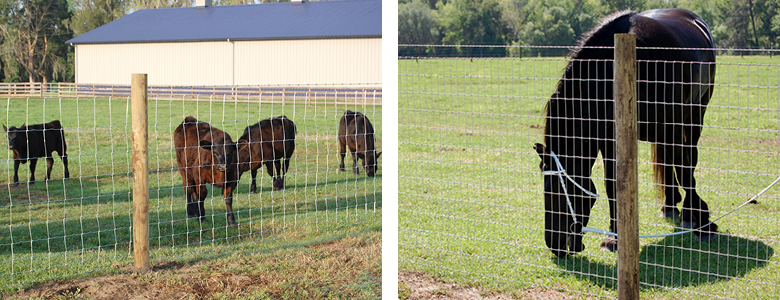From dogs to horses to herds of cattle, Red Brand has a fence that will safely contain your animals for years to come. To maximize your fence’s strength, proper installation is crucial. The easiest way to assure both longevity and durability is to install your fence on the proper side of the fence posts. By doing this, you are keeping your animals safer and your fence stronger.
Fence posts should be on the outside of the fence
A dog digging at the base, a horse leaning his head over the top, or cattle pushing against the enclosure will test your fence’s strength. The correct installation of ag fencing is to place it on the inside of the posts. This way, animals in the enclosure brush against the wire, not the posts. Fence posts that have been placed outside of the fence material will take nearly all of the animal’s force. That’s because they are better suited to withstand the weight of an animal than the staples used to hold the fencing in place.
What happens if fence posts are on the inside?
When posts are placed on the inside (closest to your animals), your fence’s strength is dependent upon staples rather than the post structure. When a horse leans against the fence to scratch an itch, most of its weight will be forced upon the staples that are securing the fence to the outside perimeter of the posts. Even staples with barbs are likely to become loose and fall out, causing the fence to sag or fail. However, a fence post that is on the outside will take the animal’s force with minimal pressure placed on the staples.

Another consideration is that posts on the inside can potentially injure animals. Loose staples can cause a gap between the fence and the post, allowing necks and legs to become stuck between the two. Keeping animals separated from untreated wood can also protect them, as posts could eventually splinter and scratch your animal’s hide.
Take Home Message
By placing fence posts on the outside, you are strengthening the fence and protecting your animals at the same time. Keeping wooden posts away from animals decreases exposure to splinters and makes gaps less frequent.
An exception to the installation rule might come into play on property lines. Be sure to review covenants or check local regulations to ensure compliance when placing your fencing along shared boundaries.
Finally, a word about proper stapling methods. Be sure to note if your staples are right-handed, or left-handed. The angle they are installed is critical to their effectiveness. Watch this short video to learn the correct way to staple fencing to posts.
More fence planning tips can be found here.
Don’t miss a thing. Simply fill out the Subscribe form here. We’ll notify you every time we add new material. See you soon!

